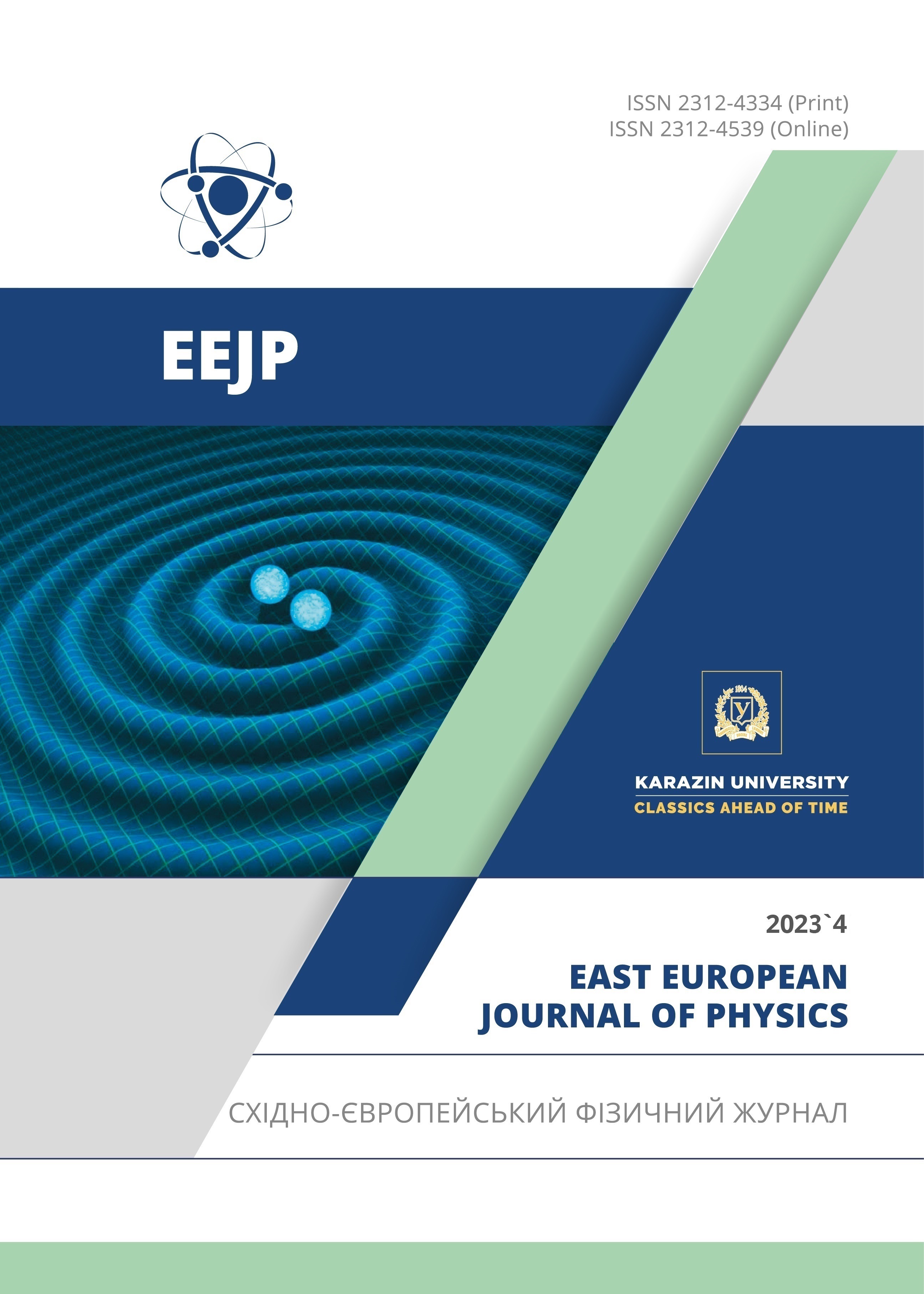Influence of silicon characteristics on the parameters of manufactured photonics cells
Abstract
The paper investigates the influence of the electrophysical characteristics of silicon on the final parameters of photoelectronic elements using p-i-n photodiodes as an example. It has been found that photodiode samples made on the basis of silicon with a higher resistivity are more prone to the formation of inversion channels at the oxide-semiconductor interface. Also, the dark current and responsivity of such photodiodes reach saturation at a lower voltage. It has also been shown that silicon-based photodiodes with a longer lifetime of non-basic charge carriers have lower dark current values. It has been shown that products with crystallographic orientation [111] have a much lower density of surface dislocations after technological operations than in the case of silicon with orientation [100]. It was also found that materials with different crystallographic orientations have different phosphorus diffusion coefficients. It has been experimentally established that a silicon oxide film grows faster on the surface of crystallographic orientation silicon [111] than on the surface of crystallographic orientation silicon [100]. This is due to the difference in the surface density of silicon atoms inherent in different crystallographic planes.
Downloads
References
M.K. Bakhadyrkhanov, S.B. Isamov, Z.T. Kenzhaev, D. Melebaev, K.F. Zikrillayev, and G.A. Ikhtiyarova, Applied Solar Energy, 56, 13-17 (2020). https://doi.org/10.3103/S0003701X2001003X
H. Helmers, E. Lopez, O. Höhn, D. Lackner, J. Schön, M. Schauerte, and A.W. Bett, Physica status solidi – Rapid Research Letters, 15(7), 2100113 (2021). https://doi.org/10.1002/pssr.202100113
M. Kukurudziak, Radioelectronic and Computer Systems, 105(1), 92 (2023). https://doi.org/10.32620/reks.2023.1.07
A.V. Fedorenko, Technology and design in electronic equipment, 17(3–4), 17–23 (2020). https://doi.org/10.15222/ TKEA2020.3-4.17 (in Ukrainian)
W.J. Westerveld, M. Mahmud-Ul-Hasan, R. Shnaiderman, V. Ntziachristos, X. Rottenberg, S. Severi, and V. Rochus, Nature Photonics, 15(5), 341-345 (2021). https://doi.org/10.1038/s41566-021-00776-0
A. Müller, M. Ghosh, R. Sonnenschein, and P. Woditsch, Materials Science and Engineering: B, 134(2-3), 257-262 (2006). https://doi.org/10.1016/j.mseb.2006.06.054
C. Ballif, F. J. Haug, M. Boccard, P. J. Verlinden, and G. Hahn, Nature Reviews Materials, 7(8), 597-616 (2022). https://doi.org/10.1038/s41578-022-00423-2
X. Pan, S. Li, Y. Li, P. Guo, X. Zhao, and Y. Cai, Minerals Engineering, 183, 107600 (2022). https://doi.org/10.1016/j.mineng.2022.107600
U. Hilleringmann, Wiesbaden: Springer Fachmedien Wiesbaden, 5-20 (2023). https://doi.org/10.1007/978-3-658-41041-4_2
B. Son, Y. Lin, K.H. Lee, Q. Chen, and C.S. Tan, Journal of Applied Physics, 127(20), 203105 (2020). https://doi.org/10.1063/5.0005112
M.S. Kukurudziak, Journal of nano- and electronic physics, 14(4), 04015 (2022). https://doi.org/10.21272/jnep.14(4).04015
E. Sirtl, and A. Adler, Z. Metallk, 119, 529–31 (1961).
F.A. Abdullin, and V.E. Pautkin, in: 2019 IEEE International Seminar on Electron Devices Design and Production (SED), 2023. https://doi.org/10.1109/SED.2019.8798467
S.N. Knyazev, A.V. Kudrya, N.Y. Komarovskiy, Y.N. Parkhomenko, E.V. Molodtsova, and V.V. Yushchuk, Modern Electronic Materials, 8(4), 131-140 (2022). https://doi.org/10.3897/j.moem.8.4.99385
V.M. Lytvynenko, I.M. Vikulin, Bulletin of the Kherson National Technical University, (1), 46 (2018). (in Ukrainian)
Yu.O. Kruglyak, and M.V. Strikha, Sensor Electronics and Microsystem Technologies, 16(2), 5 (2019). https://doi.org/10.18524/1815-7459.2019.2.171224 (in Ukrainian)
M.S. Kukurudziak, Journal of nano- and electronic physics, 14(1), 01023 (2022). https://doi.org/10.21272/jnep.14(1).01023
V.A. Bruk, V.V. Garshenin, and A.I. Kurnosov, Production of semiconductor devices: Textbook. ed. 3rd, revision and supplement. (Vysshaya Shkola, Moscow, 1973). (in Russian)
M.S. Kukurudziak, and E.V. Maistruk, Semicond. Sci. Technol., 38, 085007 (2023). https://doi.org/10.1088/1361-6641/acdf14
K. Ravey, Defects and impurities in semiconductor silicon, (Trans.), edited by G.N. Gorina, (Mir, Moscow, 1984). (in Russian).
M.S. Kukurudziak, Semiconductor Physics, Quantum Electronics & Optoelectronics, 25(4), 385-393 (2022). https://doi.org/10.15407/spqeo25.04.385
V.P. Maslov, A.V. Sukach, V.V. Tetyorkin, M.Yu. Kravetskyi, N.V. Kachur, E.F. Wenger, and A.V. Fedorenko, Optoelectronics and Semiconductor Technology, 53, 188–198 (2018). (in Ukrainian)
S.B. Khan, S. Irfan, Z. Zhuanghao, and S.L. Lee, Materials, 12(9), 1483 (2019). https://doi.org/10.3390/ma12091483
M.S. Kukurudziak, East Eur. J. Phys. 2, 289 (2023), https://doi.org/10.26565/2312-4334-2023-2-33
P. Haas, F. Tran, and P. Blaha, Physical Review B, 79(8), 085104. https://doi.org/10.1103/PhysRevB.79.085104
Copyright (c) 2023 Mykola S. Kukurudziak, Volodymyr M. Lipka

This work is licensed under a Creative Commons Attribution 4.0 International License.
Authors who publish with this journal agree to the following terms:
- Authors retain copyright and grant the journal right of first publication with the work simultaneously licensed under a Creative Commons Attribution License that allows others to share the work with an acknowledgment of the work's authorship and initial publication in this journal.
- Authors are able to enter into separate, additional contractual arrangements for the non-exclusive distribution of the journal's published version of the work (e.g., post it to an institutional repository or publish it in a book), with an acknowledgment of its initial publication in this journal.
- Authors are permitted and encouraged to post their work online (e.g., in institutional repositories or on their website) prior to and during the submission process, as it can lead to productive exchanges, as well as earlier and greater citation of published work (See The Effect of Open Access).








